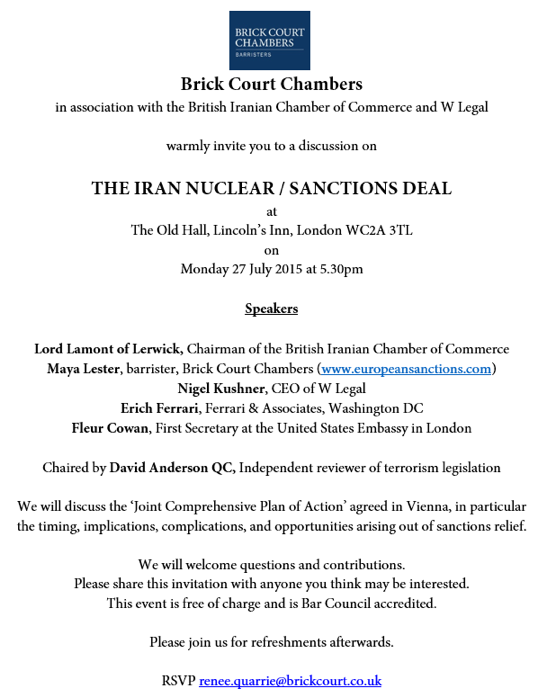Is It a New Day in Iran Sanctions?
On February 3, 2017, the U.S. Department of the Treasury’s Office of Foreign Assets Control (OFAC) added 13 individuals and 12 entities to its List of Specially Designated Nationals and Blocked Persons (SDN List) for either engaging in activities supportive of Iran’s ballistic missile program or acting for or on behalf of, or providing support to, Iran’s Islamic Revolutionary Guard Corps-Qods Force (IRGC-QF). OFAC’s designation of such individuals and entities followed Iran’s test-firing of a ballistic missile the week previous – an act that the U.S. administration regards as being in “defiance” – if not a strict violation – of United Nations Security Council Resolution 2231 (UNSCR 2231).
Quickly, some characterized this as a stepped-up enforcement action evidencing OFAC’s new posture towards perceived “aggressive” or “escalatory” action by the Iranian government. Yet, it is difficult to see how OFAC’s action is materially different from steps that the Obama administration took following Iran’s ballistic missile tests. For instance, on the same day as the Joint Comprehensive Plan of Action (JCPOA) – the nuclear accord between the U.S., other major world powers, and Iran – was implemented, the Obama administration imposed sanctions on seven (7) individuals and three (3) entities for engaging in activities supportive of Iran’s ballistic missile program. These sanctions followed close on the heels of an earlier Iranian ballistic missile test as well.
In fact, it is most likely the case that the list of individuals and entities targeted for sanctions in last week’s action was developed and assembled by the outgoing Obama administration. It was not unusual during the Obama administration for OFAC’s Office of Global Targeting (OGT) to work in tandem with the National Security Council (NSC) in developing a target list for sanctions; and according to reports, it is the NSC that developed the target list for last week’s sanctions. Considering the time and effort required to investigate procurement networks related to Iran’s ballistic missile program, it appears that the NSC was using a pre-existing target list that had been developed and assembled by the Obama administration. If so, it is difficult to characterize last week’s action as a more aggressive posture by the Trump administration towards Iran.
Indeed, the Trump administration’s first significant action on the sanctions front remains fully consistent with the approach taken under the Obama administration. Will that consistent approach last, though? Considering the threatening language used by the Trump administration towards Iran last week – first by National Security Advisor Michael Flynn, later by President Donald Trump himself – it is entirely unclear whether the recent sanctions announcement is a launching-off point for more penetrating action to tackle Iranian conduct separate and apart from the nuclear accord (e.g., its more ballistic missile program or its destabilizing activities in the Middle East) or is a sign that the Trump administration will deviate little from the approach taken by the Obama administration.
Whether the Trump administration puts its weight behind pending sanctions legislation in Congress could provide early answer, however. There are several proposed bills aimed at imposing new sanctions on Iran, but most share at least one central provision: the imposition of broad sectoral sanctions on those sectors of Iran’s economy that provide support, directly or indirectly, to Iran’s development of ballistic missiles or technologies relevant to such program (e.g., 1, 2, and 3). If enacted, such legislation would impose broad-based sectoral sanctions on Iran that effectively dwarf those sanctions imposed on Iran prior to the JPOA’s sanctions-lifting. Even if such sanctions did not amount to a technical violation of U.S. obligations under the JCPOA – an argument that is less than compelling when read against the full panoply of U.S. sanctions-related commitments – they would clearly frustrate Iran’s ability to reap practical economic value from the JCPOA’s sanctions-lifting and could thus fatally undermine continued implementation of the nuclear accord. We should be able to get a clear read on the new administration’s approach in the weeks ahead.
For now, though, it is important to exhibit caution regarding some of the rhetorical excesses of the new administration. Despite last week’s sanctions announcement and the declaration that Iran is now “on notice”, we still lack a clear idea as to OFAC’s enforcement posture towards Iran in the weeks and months ahead. In background briefings, senior administration officials have likewise noted that they were in the middle of a policy review vis-a-vis Iran and would let the deliberative process unfold before clearly identifying the new administration’s future intentions. It will thus be a waiting game for the time being.



